

"I'm Glad There Is You (In This World of Ordinary People)" is a song written by Jimmy Dorsey and Paul Madeira (sometimes credited as Paul Mertz) first published in 1941. [1] It has become a jazz and pop standard.


"I'm Glad There Is You (In This World of Ordinary People)" is a song written by Jimmy Dorsey and Paul Madeira (sometimes credited as Paul Mertz) first published in 1941. [1] It has become a jazz and pop standard.
The song was released by Jimmy Dorsey and His Orchestra in 1942 by Decca Records backed with "Tomorrow's Sunrise" featuring Bob Eberly on vocals. [2] The song was recorded on December 22, 1941, in New York City. [3] The recording was reviewed in Billboard : "With the customary Dorsey eclat, Jimmy enters two new ballads in this couplet....Maestro Jimmy had a hand in writing the plattermate. It's a love song, with the story steeped in philosophical thoughts rather than June-moon wordage. Eberly sings it from edge, saxophones and Jimmy's clarinet carving a half chorus for themselves before Bob is brought back to finish it out." [4] The song was also released in 1946, recorded on February 6, 1946, by Jimmy Dorsey and His Orchestra with Dee Parker on vocals. The B side was "Ain't Misbehavin".
The 1941 original Decca recording by Jimmy Dorsey and His Orchestra featuring Bob Eberly on vocals appears on the 2011 various artists compilation album 100 Swing Jazz Classics by Masters Classics Records. The 1946 Decca re-recording by Jimmy Dorsey and His Orchestra featuring Parker on vocals appears on the 2011 collection Jazz Compilation, Vol. 1 by Digital Natives.
Jimmy Dorsey and Paul Madeira Mertz collaborated on the lyrics and the music. Paul Madeira, who is also known as Paul Madeira Mertz, was a jazz pianist and arranger who had first worked with Jimmy and Tommy Dorsey in 1922 in their first orchestra The Wild Canaries. Mertz had been a pianist in the Bix Beiderbecke band The Rhythm Jugglers in the 1920s and had worked in Hollywood on film music from the 1930s to the 1960s. He had played on the 1925 jazz classic "Davenport Blues" in 1925 released on Gennett Records. Mertz also played piano on the 1927 Grammy Hall of Fame inductee "Singin' the Blues" by Frankie Trumbauer and his Orchestra featuring Bix Beiderbecke, Eddie Lang, and Jimmy Dorsey. He had also composed the jazz instrumental "Hurricane", which was recorded by Miff Mole and Red Nichols in 1927.

The song has since been recorded by numerous artists. [5] [6] [7] "I'm Glad There is You" has been covered by Frank Sinatra, Carmen McRae, Ella Fitzgerald, Lena Horne, Ginny Simms, Adam Jackson, Stan Kenton, Mel Tormé, Tony Bennett, Grover Washington Jr., Paul Anka, Polly Bergen, Gene Ammons, Alvino Rey, Chris Connor, Jamie Cullum, Anita Kerr Singers, Arthur Prysock, Lillie Kae, Chet Baker, Sarah Vaughan, Mildred Bailey, Ray Anthony, Dorothy Squires, Shirley Bassey, Jack Jones, Smokey Robinson, Johnny Mathis, Robert Goulet, Meredith MacRae, Joe Pass, the New Glenn Miller Orchestra under Ray McKinley, Connie Francis, Natalie Cole, Johnny Hartman, Julie London, Jackie Gleason, Cannonball Adderley, Rosemary Clooney, The Temptations, Toni Tennille, The Lettermen, Dick Hyman, Chris Montez, Boots Randolph, Nancy LaMott, June Christy, Duke Pearson Trio, Wesla Whitfield, Helen Carr, Sheila Guyse, Don Cherry, Jane Monheit, Randy Crawford, Matt Monro, The Four Freshmen, Sammy Davis Jr., Dorothy Dandridge, Hazel Scott, Art Garfunkel, Stan Kenton, Oscar Peterson, Barney Kessel, Kenny Burrell, Rahsaan Roland Kirk, Stan Getz, Peggy Lee, Gloria Lynne, Vic Damone, Freddy Cole, Jean Laughlin, Tommy Joy, Jamie Cullum, Charlie Watts, Beyoncé Knowles, Rachael MacFarlane, Seth MacFarlane, Claire Martin and Eugene Chadbourne with Paul Lovens.
The Frank Sinatra version, released as a Columbia Records single, 40229, appeared in the Cashbox magazine best-selling record charts in 1954, reaching no. 40 on May 22, 1954.
The song has appeared in the movie Playing by Heart (1998) in a recording by Chet Baker and in My Sex Life ... or How I Got Into an Argument (1996) in a recording by Ella Fitzgerald. [8] [9]
Meredith MacRae sings the song in Petticoat Junction Season Seven, episode 15 in 1970. The song also features in Season One, Episode 24 of The Cosby Show in 1985, performed by Lena Horne. Lena Horne also performed the song on The Muppet Show in the first season in 1976. The song also appeared on The Today Show in 1995, The Jack Benny Show in 1964, and The Frank Sinatra Show in 1957, and on an episode of The Millionaire in 1955.
In the 1984 film No Small Affair , Chrissy Faith (providing the singing voice for Demi Moore) sings the song in a wedding reception scene, singing an arrangement by the film's composer, Rupert Holmes. It can be viewed on YouTube.

Ernest Loring "Red" Nichols was an American jazz cornetist, composer, and jazz bandleader. He was one of the most prolific and influential jazz musicians in the late 1920s and early 1930s, appearing on over 4,000 recordings. In 1959, a biopic was made of his life and career, The Five Pennies, starring Danny Kaye.
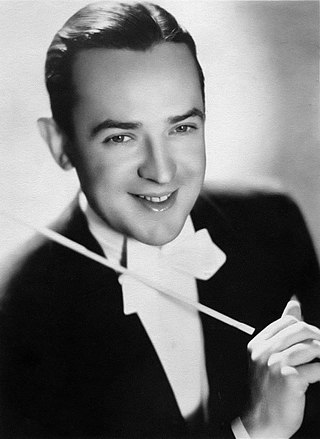
James Francis Dorsey was an American jazz clarinetist, saxophonist, composer and big band leader. He recorded and composed the jazz and pop standards "I'm Glad There Is You " and "It's The Dreamer In Me". His other major recordings were "Tailspin", "John Silver", "So Many Times", "Amapola", "Brazil ", "Pennies from Heaven" with Bing Crosby, Louis Armstrong, and Frances Langford, "Grand Central Getaway", and "So Rare". He played clarinet on the seminal jazz standards "Singin' the Blues" in 1927 and the original 1930 recording of "Georgia on My Mind", which were inducted into the Grammy Hall of Fame.
The Victor Recording Orchestra was a jazz band led by Jean Goldkette. It was known for its innovative arrangements and strong rhythm.
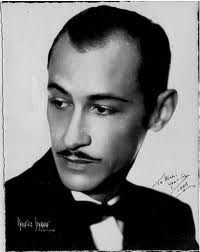
Orie Frank Trumbauer was an American jazz saxophonist of the 1920s and 1930s. His main instrument was the C melody saxophone, a now-uncommon instrument between an alto and tenor saxophone in size and pitch. He also played alto saxophone, bassoon, clarinet and several other instruments.

Marion "Buddy" Childers was an American jazz trumpeter, composer and ensemble leader. Childers became famous in 1942 at the age of 16, when Stan Kenton hired him to be the lead trumpet in his band.
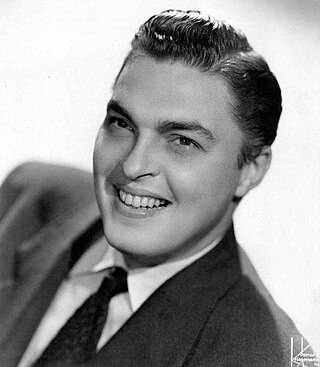
Robert Eberly was an American big band vocalist best known for his association with Jimmy Dorsey and his duets with Helen O'Connell. His younger brother Ray was also a big-band singer, making his name with Glenn Miller and His Orchestra.
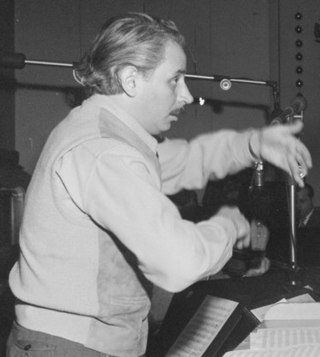
Leonard George Hayton was an American musician, composer, conductor and arranger. Hayton's trademark was a captain's hat, which he always wore at a rakish angle.
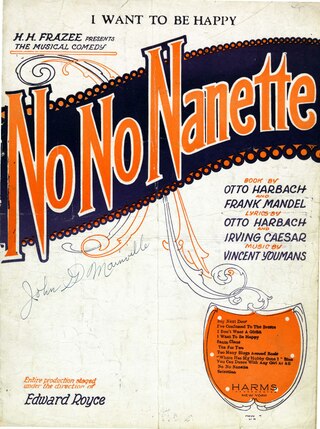
"I Want to Be Happy" is a song with music by Vincent Youmans and lyrics by Irving Caesar written for the 1925 musical No, No, Nanette.
"Pennies from Heaven" is a 1936 American popular song with music by Arthur Johnston and lyrics by Johnny Burke. It was introduced by Bing Crosby with Georgie Stoll and his Orchestra in the 1936 film of the same name.
"Imagination" is a popular song with music written by Jimmy Van Heusen and the lyrics by Johnny Burke. The song was first published in 1940. The two best-selling versions were recorded by the orchestras of Glenn Miller and Tommy Dorsey in 1940.
"I Understand" is a popular song with music by Mabel Wayne and lyrics by James Kimball "Kim" Gannon. It was published in 1941.

"Mississippi Mud" is a 1927 song written by Harry Barris, first sung by Bing Crosby as a member of Paul Whiteman's Rhythm Boys. Its musical composition entered the public domain on January 1, 2023.

Carl Kress was an American jazz guitarist.
"Stairway to the Stars" is a popular song composed by Matty Malneck and Frank Signorelli, with lyrics by Mitchell Parish. It was based on a theme from Malneck and Signorelli's 1934 instrumental piece, "Park Avenue Fantasy."
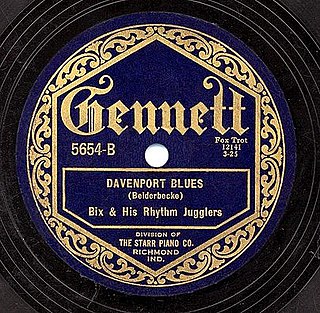
Davenport Blues is a 1925 jazz composition written and recorded by Bix Beiderbecke and released as a Gennett 78. The song has become a jazz and pop standard.

"It's the Dreamer in Me" is a 1938 song composed by Jimmy Dorsey and Jimmy Van Heusen, which was first recorded by Jimmy Dorsey and His Orchestra with Bob Eberly on vocals. Jimmy Dorsey composed the music. The lyrics were written by Jimmy Van Heusen. The song is a jazz and pop standard.
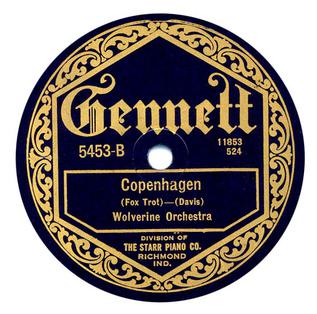
Copenhagen is a jazz standard composed in 1924 by bandleader Charlie Davis and first recorded in that year by the Wolverine Orchestra featuring Bix Beiderbecke in a foxtrot tempo. The title refers to Copenhagen tobacco, favored by Davis's bass player. Lyrics were added by Walter Melrose to the tune, which is a blues in B-flat.
"Star Eyes" is a song from the 1943 film I Dood It, written by Gene de Paul and Don Raye. It was performed in the film by Helen O'Connell and Bob Eberly accompanied by Jimmy Dorsey's orchestra. Jimmy Dorsey was the first to release the song.

"Singin' the Blues" is a 1920 jazz composition by J. Russel Robinson, Con Conrad, Sam M. Lewis, and Joe Young. It was recorded by the Original Dixieland Jass Band in 1920 as an instrumental and released as a Victor 78 as part of a medley with "Margie". The song was released with lyrics by vocalist Aileen Stanley in 1920 on Victor. In 1927, Frank Trumbauer, Bix Beiderbecke, and Eddie Lang recorded and released the song as an Okeh 78. The Trumbauer recording is considered a jazz and pop standard, greatly contributing to Frank Trumbauer and Bix Beiderbecke's reputation and influence. It is not related to the 1956 pop song "Singing the Blues" first recorded and released by Marty Robbins in 1956.
The Big Band and Jazz Hall of Fame is part of a US-based non-profit organization that began operations in 1978 and continues to the present (2022) in San Diego County, California. David Larkin is current president.